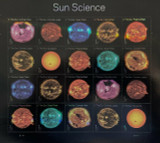THE KANSAS-NEBRASKA OVERPRINTS OF 1929
As early as 1899, the Post Office Department had considered marking stamps to help identify those stolen from post offices. Printing technology during the early years of the twentieth century, however, made implementation of the idea unfeasible.
The development of the rotary press changed that. In 1929 a postal inspector again advanced the idea of marking stamps, stressing that $200,000 worth of stolen stamps had been "fenced" the previous year. His argument convinced postal officials, and a plan was formulated to overprint stamps with the names for all forty-eight states for distribution to all but the very largest post offices.
Officials at the Bureau of Engraving and Printing objected to the plan as impractical. They agreed, however, to overprint stamps for Kansas and Nebraska (in the territory of the inspector who devised the plan). The Bureau overprinted eleven stamps for each state, the 1-cent through 10-cent values of the Fourth Bureau Issue, perforated 11x10.5. All post offices in Kansas and Nebraska received overprinted stamps except for Kansas City, Topeka, and Wichita, Omaha, and Lincoln. Although the stamps went on sale at the Philatelic Sales Agency in Washington on May 1, 1929, known use in Kansas and Nebraska occurred as early as April 15.
The overprinted stamps created mass confusion. Although the stamps were valid for use anywhere in the country, some postmasters thought they could be used only in Kansas and Nebraska. Others thought they were precancels. False reports of stolen stamps circulated. The failed experiment was cancelled in less than a year, and the Bureau never overprinted stamps for the other forty-six states.
Stamps exist with counterfeit Kansas and Nebraska overprints. Genuine overprints have gum with only one gum breaker and striated ridges. This simple examination will help identify many counterfeits.
Recent Posts
-
SOLAR ECLIPSE, SUN WORSHIPPERS, AND MORE!!!
Last week's solar eclipse over a large portion of North America, aroused the curiosity of not just a …Apr 12th 2024 -
USPS FOCUS ON SHARK EDUCATION AND PRESERVATION
The United States Postal Service (USPS) has commemorated the fascinating world of sharks through a s …Apr 5th 2024 -
REPRINTING THE MOST SOUGHT AFTER US ERROR! THE INVERTED JENNY
The original Inverted Jenny stamp, issued in 1918, was meant to depict a Curtiss JN-4H biplane used …Mar 20th 2024




